Find rubies in Greenland’s nature: This researcher gives 17 tips for ruby hunting

By Sara Kirstine Hald
With a combination of luck, patience and knowledge about rubies, you might be able to find the precious gems in the nature around you. To prepare you for ruby hunting, we give you geologist and researcher Majken Djurhuus Poulsen’s 17 tips for finding rubies.
Majken Djurhuus Poulsen who was born and raised in Greenland has always been interested in stones and geology. She is particularly fascinated by jewelry and gemstones. Therefore, she has made it her livelihood to, among other things, research rubies.
“Ever since I was a kid, I’ve always been the kind of person who went searching for beautiful stones. When we were out sailing in my childhood, I was always aware of what I saw around me. I walked along the beach, looking, and was curious about everything,” Majken Djurhuus Poulsen says.
As a geologist at GEUS (The National Geological Survey of Denmark and Greenland), she has helped investigate the chemical composition of rubies found in Greenland. They differ from rubies from other countries as they are formed in a special environment. More on that later.
Majken Djurhuus Poulsen has also helped establish that the Greenlandic rubies are the world’s oldest, and last year she completed her Ph.D. on rubies in East Greenland.
“Once you find one, you want to do it again and again”
Before Majken found her first ruby, she would walk around for a long time looking without quite knowing what she was looking for. But once she found one, finding more became easier. And she was hooked.
“Once you’ve found one, you want to do it again and again. And I get it if private citizens also want to try,” Majken Djurhuus Poulsen says.
If she is out in nature with other purposes, an urge to look for rubies always arises. And she has previously experienced being out looking for soapstone but also finding rubies because ‘you can’t help it once you know what to look for’.
Majken Djurhuus Poulsen has thus been quite hooked on hunting the red stones, and describes it as a sort of detective work:
“When I’m looking for rubies, I feel like a little detective. I know what to look for and then it’s pretty crazy when the hunt is a success,” Majken Djurhuus Poulsen says.
If you also want to know what to look for to find rubies, check out Majken Djurhuus Poulsen’s 17 tips for ruby hunting below.
1) Know your corundum
First of all, you need to have some basic knowledge about rubies, so you know what it really is you are looking for.
Rubies consist of the mineral corundum, which comes in many different colors. If the corundum is read and clear, it is categorized as a ruby. If it is clear, but has a color other than red, it is called a sapphire. A blue sapphire is simply called a sapphire. However, sapphires in other colors are called “yellow sapphire”, “pink sapphire”, “green sapphire” and so on.
If the corundum is not clear, it is simply corundum – no matter the color of it.
So, if you are going hunting for rubies, you are first and foremost going hunting for corundum. And then, if the corundum has the right color and quality, you might be lucky it is a ruby.

Majken Djurhuus Poulsen is born and raised in Greenland and is specialized in Greenlandic rubies.
Photo: Sara Kirstine Hald

Rubies consist of the mineral corundum; The crystalline form of aluminium oxide which is a chemical connection between aluminium and oxygen. The green in this rock is amphibole, the black is mica minerals, and the red is rubies.
Photo: Sara Kirstine Hald
2) Search for ultramafic rocks
Greenlandic rubies are found in so-called ultramafic rocks, which is special for rubies from Greenland. In Majken’s pictures below, you can see some examples of ultramafic rocks.
Ultramafic rocks are dark and typically have a slightly reddish or brownish color. However, the surface might also appear a bit green. The surrounding rocks are usually lighter in color, which makes the ultramafic rocks easier to spot.
Ultramafic rocks are often shaped like “knobs”, which, according to Majken Djurhuus Poulsen, resemble a lunar landscape. There is almost never any vegetation on them, which makes them easier to locate.
If you are in doubt whether you have found an ultramafic rock, you can try holding a magnet to it. The stones typically consist of, among other things, iron-rich and magnesium-rich minerals, which is why they are sometimes magnetic.
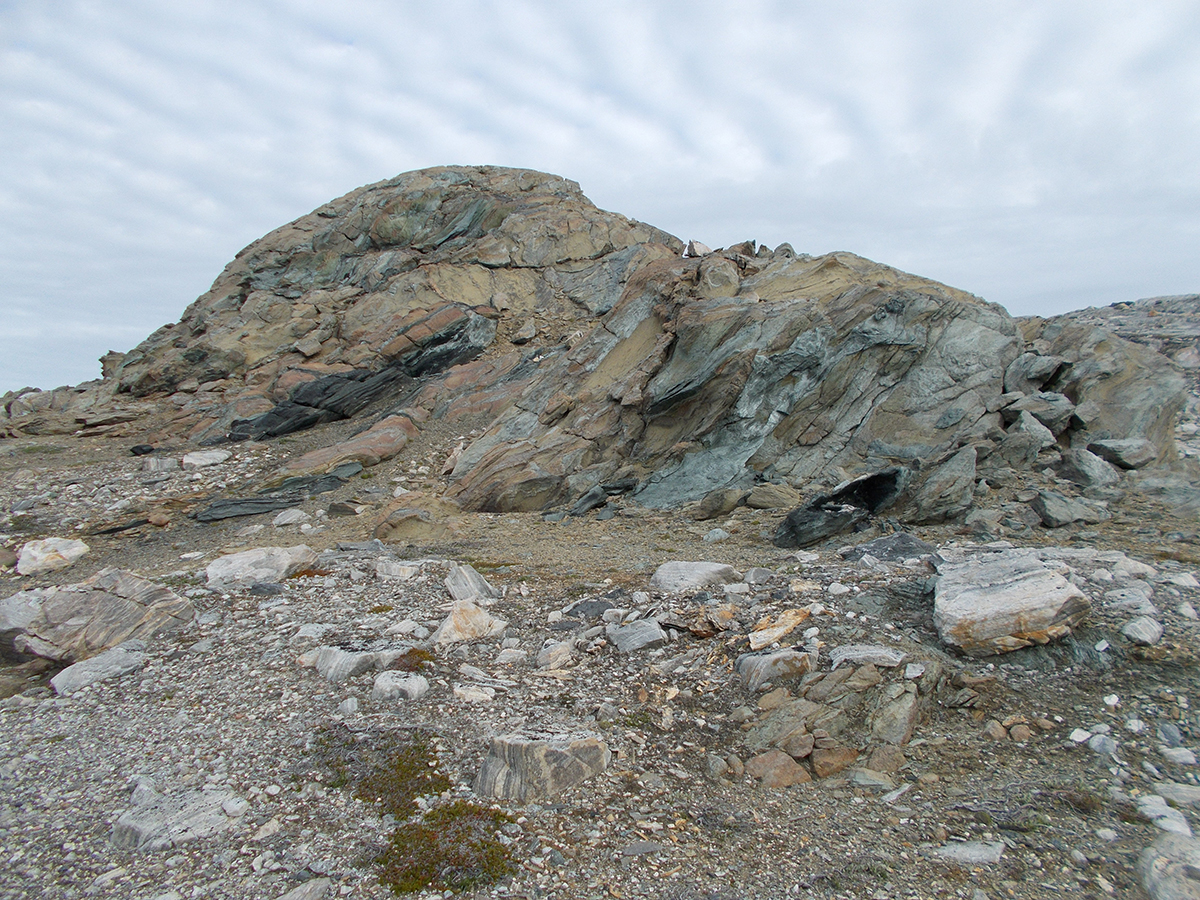

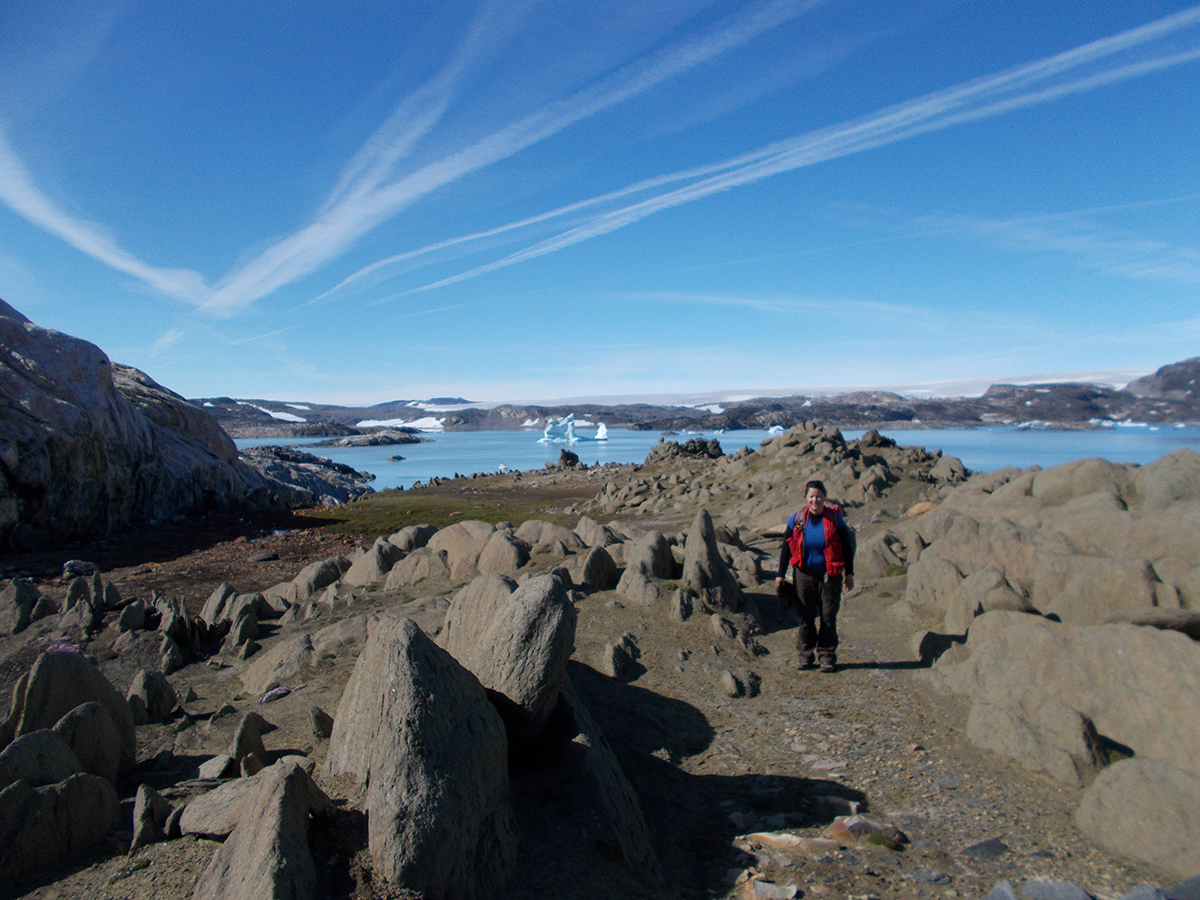
3) Search in the old bedrock
The areas with ultramafic rocks are found in the old bedrock. Majken Djurhuus Poulsen calls them “lentils” and you can see examples of such in the picture below. The lentils are marked in red.
The old bedrock, which is part of the continental plate under Greenland, stretches from Qeqertarsuatsiaat (Fiskenæsset) to Nuuk and up around Sisimiut. Therefore, this is where it is possible to find corundum. The same goes for the Tasiilaq area.

The ultramafic rocks occur as “lentils” in the bedrock. Here, they are marked in red.
Photo: Majken Djurhuus Poulsen, own markings
4) Use a geological map
Sometimes, the ultramafic rocks are marked on geological maps. You can find these maps on the internet, and they can be of great help.
You can find geological maps of Greenland at greenmin.gl.
On the geological maps, ultramafic rocks are marked with purple. For example, if you look at the map of the Nuuk area, which you will find below, you can see that there are ultramafic rocks on Qoornup Qeqertarsua (Bjørneøen) and around Sermitsiaq.
Be aware though, that not all areas with ultramafic rocks are marked on the maps. If, for example, there is only a single, smaller lentil, it might not appear on a map. So, the maps are not a complete guide, but they might be useful as an indicator.

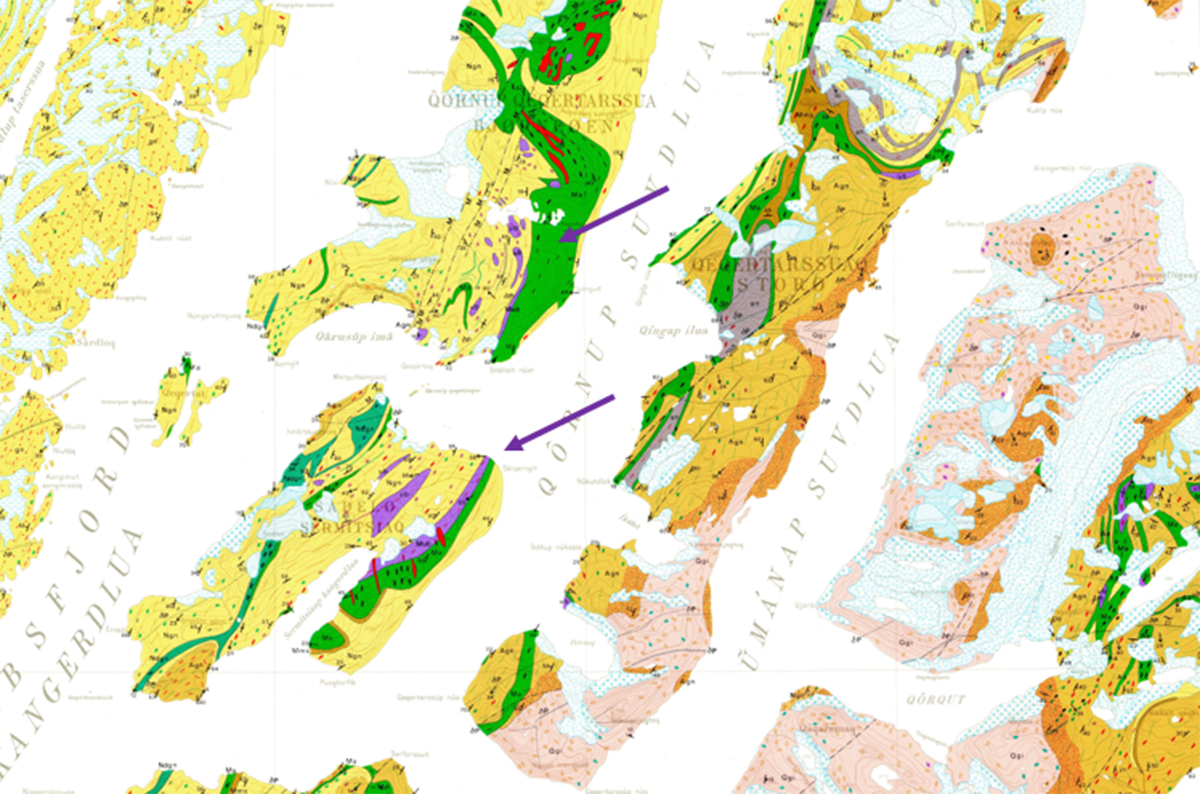
The geological map ‘Qorqut’, scale 1:100,000. The colors on the map mark different rock types; yellow = gneiss, green = amphibolite, purple = ultramafic rock, gray = anorthosite, pink = Qorqut granite, red = pegmatite, orange = metamorphic sediments.
Source: Greenmin.gl, ©GEUS, own markings
5) Look for veins and joints in the rock
Once you’ve found the ultramafic rock, you must look for places where it has reacted with another rock.
“For there to be rubies in an ultramafic rock, there must have been a change in its minerals due to a reaction with another rock,” Majken Djurhuus Poulsen says.
For example, in some places you will see a light vein running through the rock or a ring around the edge of the rock that has a different color than the rest. In these collisions between ultramafic rocks and rocks with different chemical compositions, it is possible to find rubies.
In Majken’s pictures below, you can see examples of what it looks like when an ultramafic rock has reacted with another rock type.

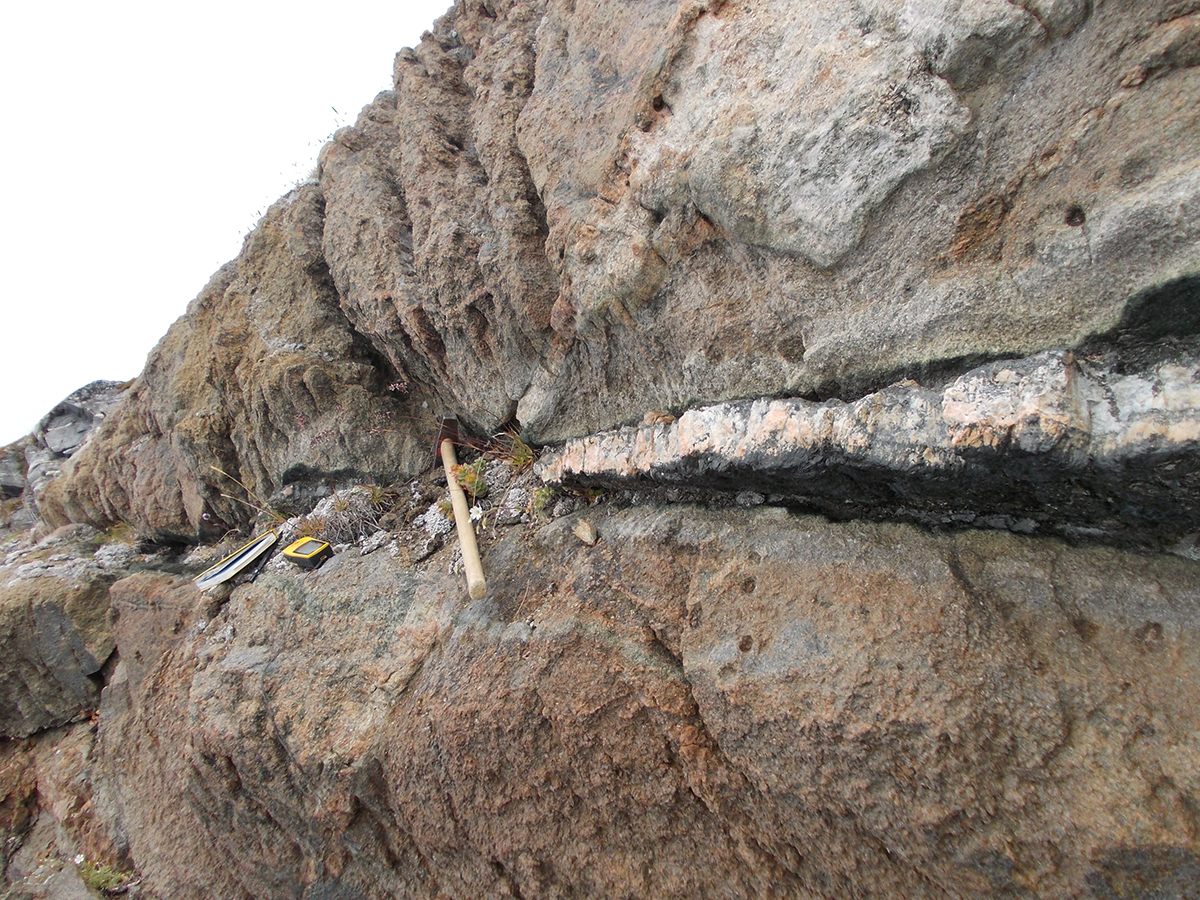
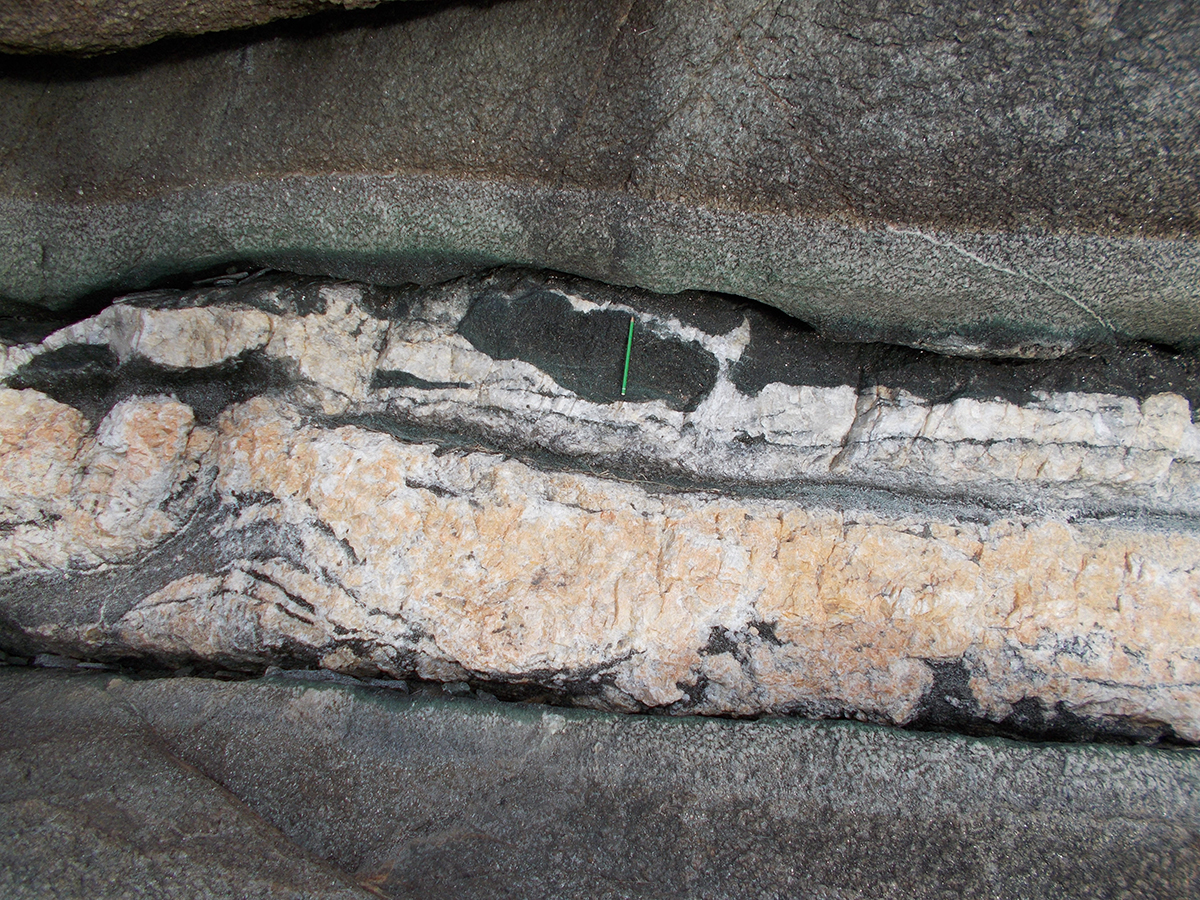

6) Don’t lose hope
According to Majken Djurhuus Poulsen, there is a real chance of finding rubies if you go hunting for rubies as a private citizen. However, it does require a little practice and patience.
First of all, you need to learn how to spot the ultramafic rocks. Once you can do that, you are well on track. Then, what you need to do is spend time examining joints and veins for rubies.
“You have to walk around them and see if there is anything sticking out somewhere that looks different. And if you don’t find anything, just move along to the next area with ultramafic rock,” Majken Djurhuus Poulsen says.
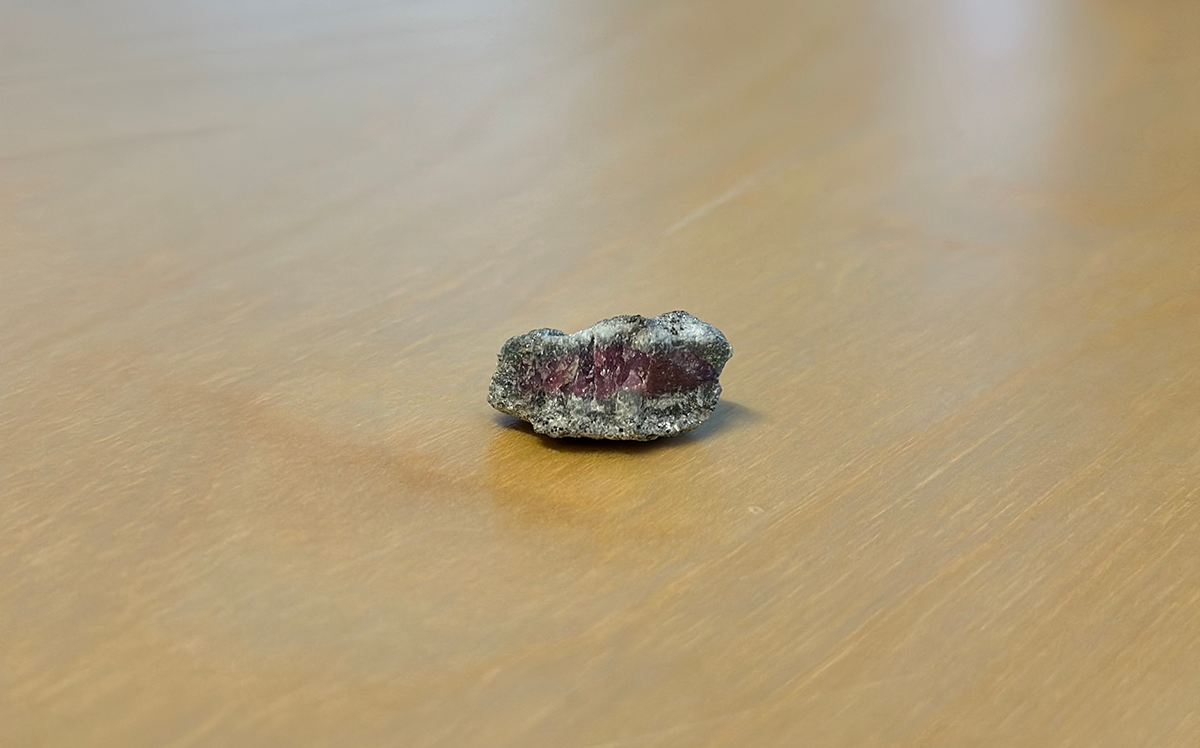
Ruby found by a private citizen in the Kapisillit area.
Photo: Sara Kirstine Hald
7) Go ruby hunting when there isn’t any snow
Preferably, there should not be any snow when you go ruby hunting. Snow makes it difficult to examine the ultramafic rocks properly, so it is almost impossible to look for corundum during the winter.
8) Avoid rain
According to Majken Djurhuus Poulsen, rainy weather might make it more difficult to find rubies. When it rains, the ultramafic rocks become a bit darker in color because of the water, and that makes them harder to spot in the landscape.
9) Search both up and down
The ultramafic rocks are scattered randomly throughout the entire bedrock. This means, that you can find corundum both right by the edge of the water and at heights.
10) Bring a hammer and chisel
Rubies can be hard to extract from the joints or veins they are sitting in. That is why it is a good idea to bring a hammer and chisel when going ruby hunting. With a chisel you can get into small cracks in the stone and break off pieces.
For you to be allowed to use hammers and chisels in nature, you must be a permanent resident of Greenland. If you are, you may as a private citizen extract minerals including corundum with hand-held, non-mechanical tools – for example hammers and chisels.
More on the rules of ruby hunting later.

Majken Djurhuus Poulsen on fieldwork finding rubies in East Greenland. Here, she uses a hammer and a chisel to extract pieces of corundum from the rock.
Photo: Nynke Keulen ©GEUS
11) Test the hardness of the mineral
Corundum is the second hardest mineral in the world, only surpassed by diamond. Therefore, you cannot scratch it with a pocketknife or a key. So, if you have found a mineral that looks like a corundum, it is a good idea to test the hardness of the stone.
If you want to be able to do a more precise test than with a pocketknife, you can buy a hardness test kit, which is based on Mohs hardness scale. Mohs hardness scale ranks from one to ten and is used to measure the hardness of minerals. Thus, a hardness test kit consists of ten different minerals, each with their own hardness on the Mohs scale.
The minerals are used to scratch the minerals you find. That way, you get an idea of how hard the minerals in question are.
You can buy a hardness test kit online and it doesn’t cost a fortune.

The hardness of minerals is measured on a scale of one to ten called Mohs hardness scale.
Illustration: Sara Kirstine Hald
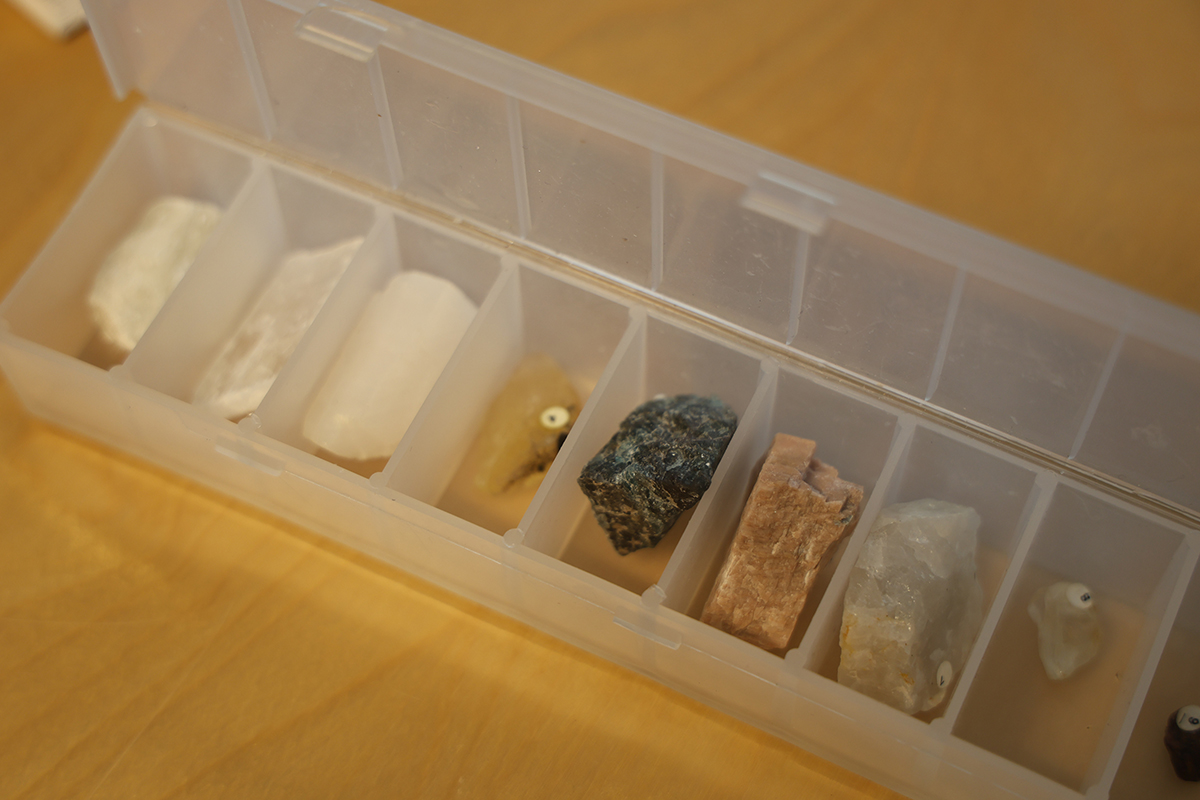
A test kit like this one contains minerals of different hardness which can be used to measure the hardness of the minerals you find.
Photo: Sara Kirstine Hald
12) Don’t waste time digging
“If there is corundum present, you will be able to see it,” Majken Djurhuus Poulsen says.
For example, corundum can be found on the ground around the ultramafic rock because it has somehow detached itself. Otherwise, it typically sticks a bit out of the rock it is sitting in, as you can see in the photos below.
“Of course, you can’t know for sure if there is corundum present inside a rock, but unless I could see it, I wouldn’t waste my energy picking the rock or digging for it. Instead, I would move on to the next ultramafic rock,” Majken Djurhuus Poulsen says.

Corundum is the second hardest mineral in the world. Therefore, it often protrudes from the softer rocks it is embedded in, as these are more easily worn away. The black and green minerals in the picture are amphibole, the black ones are mica minerals, and the pink ones are corundum.
Photo: Majken Djurhuus Poulsen

Rubies which are not of a high enough quality to be used as gemstones are used as abrasives due to their hardness.
Photo: Majken Djurhuus Poulsen
13) Bring a magnifying glass
Unless you find a large, solid corundum, it might be difficult to see it properly with the naked eye and, for example, determine whether you have managed to scratch it with you pocketknife or test kit.
To make it easier to see scratches, the structure of the mineral, and various impurities, it is helpful to bring a magnifying glass.

This solid ruby only became visible when the rock was cut open, but before that, Majken Djurhuus Poulsen could see corundum on the rock’s outer surface.
Photo: Majken Djurhuus Poulsen
14) Evaluate color and clarity of the mineral
If you find a corundum but are unsure if it qualifies as a ruby, you should look at its color and clarity. A ruby must be clear and red.
“You can use a color guide to determine if something is a ruby or, for example, a pink sapphire. But typically, that’s something a gemologist who specializes in gemstones would do,” Majken Djurhuus Poulsen says.
15) Examine the stone in ultraviolet light
One of the special features of rubies is that they fluoresce under ultraviolet light. This makes it easy to distinguish them from similar-looking stones.
“Not alle minerals fluoresce under ultraviolet light. For example, a red garnet has almost the same color as a ruby but does not fluoresce under UV light,” Majken Djurhuus Poulsen says.
So, if you’re going ruby hunting, it’s a big help to bring a UV flashlight with you. Like the hardness test kit, it’s a small investment.
Watch the video below to see what it looks like when you shine UV light on rubies.
16) Carry a field guide
Rubies have a different crystal structure than, for example, red garnet. Therefore, it can be helpful to carry a field guide that shows the difference in minerals so you can easily compare your finding with the reference material in the book.
If you have a field guide with you, you can also learn more about the minerals that you have found even if it’s not corundum. There are many other beautiful and interesting minerals in the Greenlandic nature.
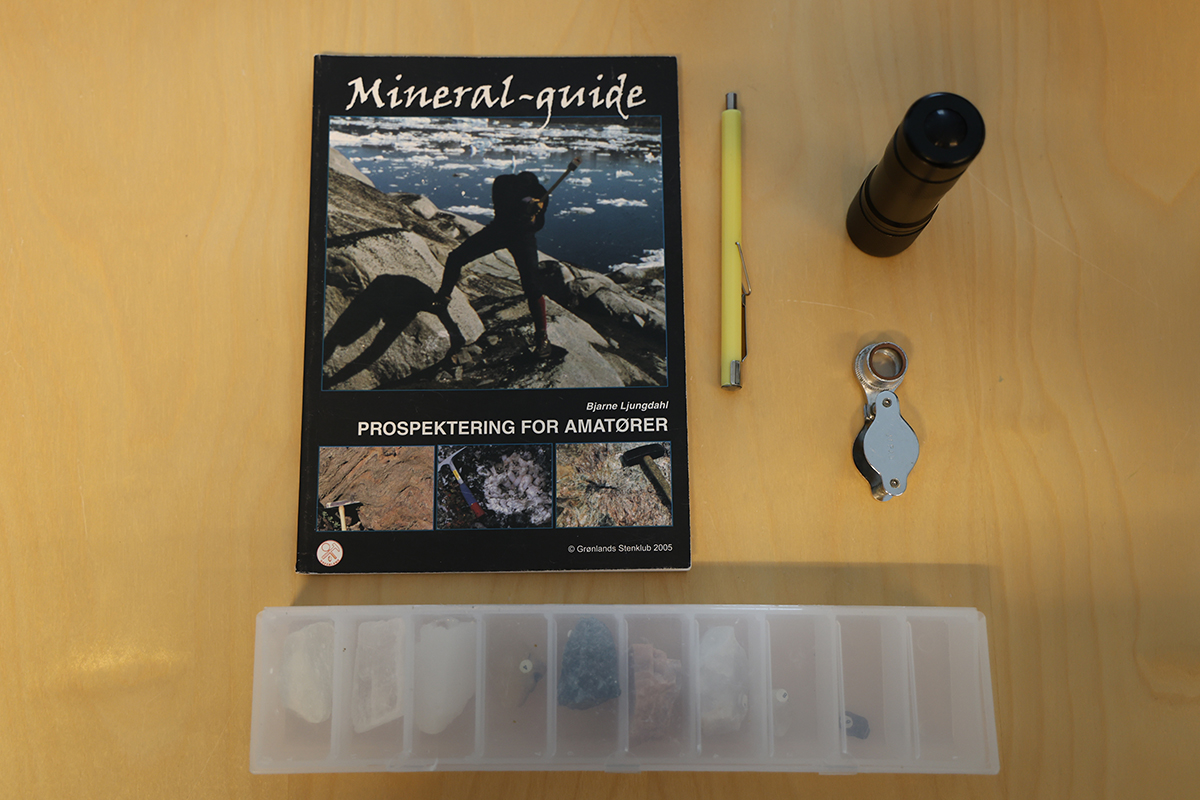
With a field guide, magnet, UV flashlight, magnifying glass, and hardness test kit, you are well-equipped to examine the minerals you find in nature. The picture mineral guide is written by geologist and author Bjarne Ljungdahl.
Photo: Sara Kirstine Hald
17) Make sure you know the rules
Before you go looking for gemstones in the Greenlandic nature, it’s wise to know what you can and cannot do.
If you are not a permanent resident, you are not allowed to collect minerals. Unfortunately. So, if you are a tourist or a temporarily residing here without full tax liability, you are not allowed to collect minerals according to the Minerals Act.
However, if you have a permanent address in Greenland and pay full Greenlandic taxes, it’s a different story. Then, you are allowed to collect loose minerals or mine minerals with a hammer and chisel. Under the Minerals Act, you can collect minerals up to a value of DKK 100,000 per year. If you need to collect more than that, you can apply for a small-scale permit.
If you plan to sell the rubies or export them from the country, there are specific rules you need to follow. But, if you are a permanent resident of Greenland and find a ruby that you want to keep for yourself, you’re free to do so – as long as there isn’t someone else who has an exclusive permit or exploitation permit for the area where you found it. In that case, you would need permission from the license holder to keep the mineral.
You can find an overview of areas covered by mineral licenses at greenmin.gl. The pink markings on the screenshot below show areas covered by a license.

Source: Greenmin.gl
Greenland’s many gemstones
After reading this guide, you might be able to find the red gemstones hidden in Greenland’s nature, which are quite valuable. For example, the first set of jewelry with Greenlandic rubies sold for DKK 85,000 at auction.
However, there are also many other gemstones than rubies to be found in the mountains around the country. This is something Majken Djurhuus Poulsen would like to explore more if she could:
“I would like to go hunting more if I could, even here in the Nuuk Fjord. I would hunt for Greenlandite, tourmaline, moonstone, beryl, and nuummit to mention a few,” Majken Djurhuus Poulsen says.
Good luck with the ruby hunt!
